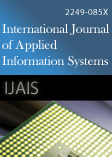
- Richard O. Oyeleke and Adetunji P. Adewole and Florence A. Oladeji 2014. Effect of Hybrid Data Compression Technique on the Diagnostic Accuracy of Region of Interest (ROI) on MRI Image of a Spine Disc Prolapse. International Journal of Applied Information Systems. 7, 5 (July 2014), 16-20. DOI=http://dx.doi.org/10.5120/ijais451197
-
@article{10.5120/ijais2017451568, author = {Richard O. Oyeleke and Adetunji P. Adewole and Florence A. Oladeji}, title = {Effect of Hybrid Data Compression Technique on the Diagnostic Accuracy of Region of Interest (ROI) on MRI Image of a Spine Disc Prolapse}, journal = {International Journal of Applied Information Systems}, issue_date = {July 2014}, volume = {7}, number = {}, month = {July}, year = {2014}, issn = {}, pages = {16-20}, numpages = {}, url = {/archives/volume7/number5/656-1197}, doi = { 10.5120/ijais14-451197}, publisher = { xA9 2013 by IJAIS Journal}, address = {} } -
%1 451197 %A Richard O. Oyeleke %A Adetunji P. Adewole %A Florence A. Oladeji %T Effect of Hybrid Data Compression Technique on the Diagnostic Accuracy of Region of Interest (ROI) on MRI Image of a Spine Disc Prolapse %J International Journal of Applied Information Systems %@ %V 7 %N %P 16-20 %D 2014 %I xA9 2013 by IJAIS Journal
Abstract
The cost of transmitting and archiving medical images are quite prohibitive due to their large sizes especially in digital radiology system such as: picture archiving and communication systems and teleradiology. In order to reduce storage requirements and improve transmission rate, there is need for compression. Usually, radiologists are only interested in the abnormal region of the image (known as the region of interest) in making diagnosis and interpretations; hence, this work investigates the effect of hybrid data compression technique on the diagnostic accuracy of region of interest (ROI) on magnetic resonance image (MRI) of a spine disc prolapsed. We extract the ROI from the original image and apply lossless Wavelet-Based Compression (WBC) on the ROI while the remainder image known as the non-region of interest is compressed using discrete cosine transform (DCT). A compression ratio of 7:1 was achieved. Finally, the diagnostic accuracy of the compressed ROI image was evaluated subjectively by a group of 30 evaluators comprising of 20 radiologists and 10 Radiographers. The results obtained show a 100% acceptance of the compressed ROI for healthy diagnosis and interpretation.
References
- P. C. Cosman, R. M. Gray and R. A. Olsen, "Evaluating quality of compressed medical images: SNR, subjective rating, and diagnostic accuracy", Retrieved from: https://www. zotero. org/rudedude/items/itemKey/SS2T2HU4, 2010.
- M. Gupta and A. K. Garg, "Analysis Of Image Compression Algorithm Using DCT", International Journal of Engineering Research and Applications (IJERA), vol. 2, issue 1, pp. 515-521, 2012.
- S. E. Ghrare, M. A. M. Ali, M. Ismail, and K. Jumari, "The Effect of Image Data Compression on the Clinical Information Quality of Compressed Computed Tomography Images for Teleradiology Applications", European Journal of Scientific Research, vol. 23, No. 1 , pp. 6-12. 2008.
- V. Kumar, J. Sharma and S. Ayub, "Image Compression using FFN for ROI and SPIHT for background, International Journal of Computer Applications", Volume 46– No. 18, 2012.
- T. H. Lee, "Introduction to Medical Image Compression Using Wavelet Transform" , Graduate Institute of Communication Engineering, National Taiwan University, 2007.
- K. Lees, "Image Compression Using Wavelets",2002.
- K. A. Radha,, and G. Shruthi, "JPEG Encoder using Discrete Cosine Transform & Inverse Discrete Cosine Transform", IOSR Journal of Electronics and Communication Engineering (IOSR-JECE) . ,vol. 5, issue 4, pp. 51-56, 2013.
- V. J. Rehna, and K. M. K. Jeya, "Hybrid Approaches to Image Coding: A Review": (IJACSA), International Journal of Advanced Computer Science and Applications, vol. 2, no. 7. , 2011.
- A. Saffor, A. B. Ramil, K. Ng, D. Dowsett, "Objective and Subjective Evaluation of Compressed Computed Tomography (CT) Images", Retrieved Available from: http: isup. com/IJRA/2/2/6159, 2010.
- K. S. Satish, "Classifying image data", Retrieved from:http://www. debugmode. com/imagecmp/classify. htm, 2001.
- Y. S. Sumathy and A. Pallavi, "Region of Interest (ROI) based Medical Image Compression and reliable transmission with application to CT images (Liver images)", Visvesvaraya Technological University, Belgaum-590018, R. N. Shetty Institute of Technology, Bangalore, 2009.
- G. Soundarya,, and S. Bhavani, "Comparison of Hybrid Codes for MRI Brain Image Compression", Research Journal of Applied Sciences, Engineering and Technology, vol4, pp. 24, 2012.
Keywords
Image compression, medical image, region of interest, image evaluation, diagnostic accuracy

 10.5120/ijais14-451197
10.5120/ijais14-451197
